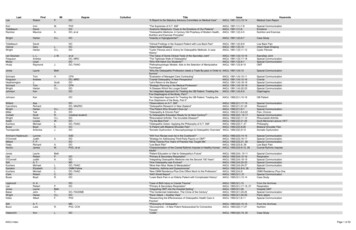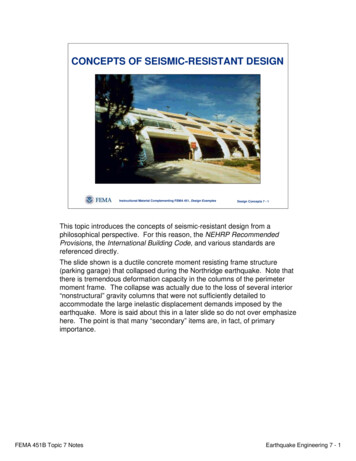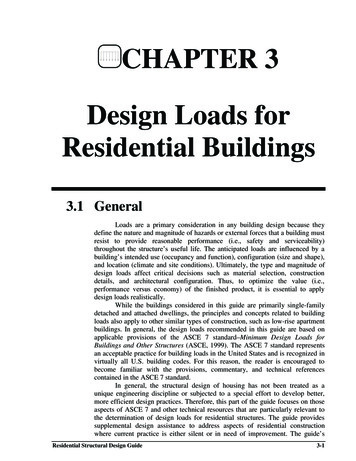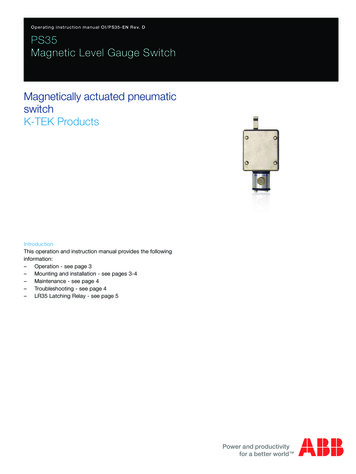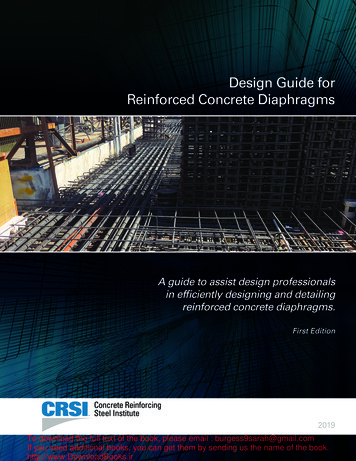
Transcription
Design Guide forReinforced Concrete DiaphragmsA guide to assist design professionalsin efficiently designing and detailingreinforced concrete diaphragms.First Edition2019To download the full text of the book, please email : burgess9sarah@gmail.comIf you need additional books, you can get them by sending us the name of the book.http://www.DownloadBooks.ir
Founded in 1924, the Concrete Reinforcing Steel Institute (CRSI) is a technical institute and an ANSI-accredited Standards DevelopingOrganization (SDO) that stands as the authoritative resource for information related to steel reinforced concrete construction. Servingthe needs of engineers, architects and construction professionals, CRSI offers many industry-trusted technical publications, standardsdocuments, design aids, reference materials and educational opportunities. CRSI Industry members include manufacturers, fabricators,material suppliers and placers of steel reinforcing bars and related products. Our Professional members are involved in the research,design, and construction of steel reinforced concrete. CRSI also has a broad Region Manager network that supports both membersand industry professionals and creates awareness among the design/construction community through outreach activities. Together,they form a complete network of industry information and support.Cover photos courtesy of Magnusson Klemencic Associates.To download the full text of the book, please email : burgess9sarah@gmail.comIf you need additional books, you can get them by sending us the name of the book.http://www.DownloadBooks.ir
Design Guide for Reinforced Concrete DiaphragmsPublicaton No:10-DG-RC-DIAPHRAGMS-2019ISBN: 978-1-943961-46-7Copyright 2019By Concrete Reinforcing Steel InstituteFirst Edition Printed 2019All rights reserved. This guide or any part thereof may not be reproduced in anyform without the written permission of the Concrete Reinforcing Steel Institute.Printed in the U.S.AThis publication is intended for the use of professionals competent to evaluate the significance and limitations of its contentsand who will accept responsibility for the application of the material it contains. The Concrete Reinforcing Steel Institutereports the foregoing material as a matter of information and, therefore, disclaims any and all responsibility for application of thestated principles or for the accuracy of the sources other than material developed by the Institute.To download the full text of the book, please email : burgess9sarah@gmail.comIf you need additional books, you can get them by sending us the name of the book.http://www.DownloadBooks.iri
Design Guide for Reinforced Concrete DiaphragmsForewordIn the 2014 edition of ACI 318, a new chapter devoted to the design and detailing of reinforced concrete diaphragms was included for the first time. The purpose of this Design Guide is to provide explanatory material based on the provisions of that chapterfor diaphragms in buildings assigned to any Seismic Design Category. Included are many design aids and worked-out exampleproblems that illustrate the proper application of the code requirements.Since the first CRSI Design Handbook in 1952, users of CRSI publications have been cooperative in suggesting to the DesignAids Committee and CRSI Staff, many improvements, clarifications and additional design short-cuts. This professional assistance is very helpful, and is appreciated. Comments on this design guide are welcome so that future editions can be furtherimproved. Please direct all comments to Mike Mota, Ph.D., P.E., SECB, F.SEI, F.ASCE, F.ACI, CRSI Vice President of Engineering.iiTo download the full text of the book, please email : burgess9sarah@gmail.comIf you need additional books, you can get them by sending us the name of the book.http://www.DownloadBooks.ir
Design Guide for Reinforced Concrete DiaphragmsContentsForewordChapter 1Introductionii1-11.1 Overview1-11.2 Definitions1-11.3 Scope1-21.4 Organization of this Publication1-2Chapter 2Materials4-134.4 Anchorage and Connection Forces4-144.4.1 Overview4-144.4.2 Wind Forces4-144.4.3 Seismic Forces4-154.5 Column Bracing Forces4-164.6 Out-of-plane Forces4-174.7 Collector Design Forces4-174.7.1 Overview4-174.7.2 Collector Design Forces for BuildingsAssigned to SDC C through F 2-12.1 Overview2-12.2 Concrete2-12.3 Nonprestressed Reinforcement2-1Chapter 3Determining theDiaphragm Thickness4.3 Transfer Forces3-1Chapter 5Load Combinations4-175-15.1 Overview5-15.2 Strength Design Load Combinations5-15.3 Seismic Load Combinations for SDC B5-35.4 Seismic Load Combinations for SDC C5-35.5 Seismic Load Combinations forSDC D, E, and F5-4 3.1 Overview3-13.2 Serviceability Requirements3-13.2.1 One-way Slabs3-13.2.2 Two-way Slabs3-1Chapter 6Diaphragm Modeling and Analysis6-13-26.1 Overview6-13.3.1 Overview3-26.2 In-plane Stiffness Modeling6-13.3.2 Flexure3-26.3 Analysis Methods6-23.3.3 Shear3-26.3.1 Overview6-23.3 In-plane Strength Requirements3-46.3.2 Load Paths for Lateral Forces6-23.4.1 Flexure3-46.3.3 Horizontal Distribution of Lateral Forces6-33.4.2 One-way Shear3-46.3.4 ACI 318 Analysis Methods6-73.4.3 Two-way Shear3-53.4 Out-of-plane Strength Requirements3.5 Minimum Diaphragm Thickness forSDC A, B, and C 3-96.4 Beam Models6-86.4.1 Overview6-86.4.2 Equivalent Beam Model withRigid Supports 3.6 Minimum Diaphragm Thickness forSDC D, E, and F 3-96.4.3 Corrected Equivalent Beam Modelwith Spring Supports6-8 Chapter 4Diaphragm Design Forces4-14.1 Overview4-14.2 In-plane Forces4-14.2.1 Wind Forces4-14.2.2 General Structural Integrity Forces4-64.2.3 Seismic Forces4-66-116.5 Strut-and-Tie Models6-156.6 Finite Element Models6-156.7 Alternative Models6-16Chapter 7Design Strength7-17.1 Overview7-17-17-24.2.4 Soil Lateral Forces4-117.2 Strength Reduction Factors4.2.5 Flood and Tsunami Forces4-127.3 Nominal StrengthTo download the full text of the book, please email : burgess9sarah@gmail.comiiiIf you need additional books, you can get them by sending us the name of the book.http://www.DownloadBooks.ir
Design Guide for Reinforced Concrete Diaphragms7.3.1 Overview7-29.4 Step 3 – Determine the Diaphragm Design Forces 9-17.3.2 Moment and Axial Forces7-27.3.3 Shear7-27.3.4 Shear Transfer7-39.5 Step 4 – Determine the Classification of theDiaphragm, Select the Diaphragm Model,and Determine the Diaphragm Internal Forces9-27.3.5 Collectors7-39.6 Step 5 – Determine the Combined Load Effects9-29.7 Step 6 – Determine the Chord Reinforcement9-29.8 Step 7 – Determine the Diaphragm ShearReinforcement9-29.9 Step 8 – Determine the Shear TransferReinforcement9-29.10 Step 9 – Deterimine the Reinforcement Dueto Eccentricity of Collector Forces9-29-2Chapter 8Determining and Detailingthe Required Reinforcement 8-1 8.1 Overview8-18.2 Diaphragm Reinforcement Limits8-18.3 Reinforcement Detailing Requirements8-19.11 Step 10 – Determine the Anchorage andConnection Reinforcement8.4 Chord Reinforcement8-29.12 Step 11 – Determine the Collector Reinforcement 9-3 8.4.1 Required Area of Chord Reinforcement8-28.4.2 Location of Chord Reinforcement8-28.4.3 Compression Chords8-38.5 Diaphragm Shear Reinforcement8-48.6 Shear Transfer Reinforcement8-5Chapter 10Examples10-110.1 Overview10-110.2 Examples 10.1 – One-story Retail Building(SDC A)10-110.3 Example 10.2 – Seven-story Office Building(SDC B)10-1610.4 Example 10.3 – Eighteen-story ResidentialBuilding (SDC C)10-3810.5 Example 10.4 – Thirty-story Office Building(SDC D)10-6310.6 Example 10.5 – Five-story ResidentialBuilding (SDC D)10-85 8.6.1 Overview8-58.6.2 Shear Transfer in a Diaphragm8-58.6.3 Required Shear Transfer ReinforcementBetween the Diaphragm and the VerticalElements of the LFRS – ConstructionMethod A 8-6 8.6.4 Required Shear Transfer ReinforcementBetween the Diaphragm and the VerticalElements of the LFRS – ConstructionMethod B 8.6.5 Required Shear Transfer ReinforcementBetween the Diaphragm and theCollector Elements 8-98-10Chapter 11References8.7 Required Reinforcement Due to Eccentricityof Collector Forces8-11Notations8.8 Anchorage Reinforcement8-11 8.8.1 Overview8-118.8.2 General Structural Integrity Forces8-118.8.3 Wind Forces8-128.8.4 Seismic Forces8-128.9 Collector Reinforcement8-138.9.1 Overview8-138.9.2 Slabs8-138.9.3 Beams8-158.9.4 Subdiaphragms8-178.10 Summary of Design and DetailingRequirements11-1N-1 Chapter 9Design Procedureiv8-179-19.1 Overview9-19.2 Step 1 – Select the Materials9-19.3 Step 2 – Determine the Diaphragm Thickness9-1To download the full text of the book, please email : burgess9sarah@gmail.comIf you need additional books, you can get them by sending us the name of the book.http://www.DownloadBooks.ir
Design Guide for Reinforced Concrete DiaphragmsChapter 1Introduction1.1 OverviewThe purpose of this publication is to assist in the analysis, design, and detailing of reinforced concrete diaphragms in accordancewith the 2014 edition of Building Code Requirements for Structural Concrete (ACI 318-14) and Commentary (ACI 318R-14) [Reference 1].One of the main goals is to provide step-by-step design procedures and design aids that make designing and detailing reinforcedconcrete diaphragms simpler and faster. The procedures and design aids contained in this publication can be used in the designand detailing of reinforced concrete diaphragms in buildings of any size that are assigned to Seismic Design Categories A through F.The 2018 edition of the International Building Code (IBC) [Reference 2] references ACI 318-14, and Section 1901.2 of the IBC requires that structural concrete be designed and constructed in accordance with the provisions of Chapter 19 of the IBC and the2014 edition of ACI 318 as amended in IBC Section 1905. Thus, ACI 318 is part of the IBC and its applicable provisions must besatisfied when the IBC is adopted in a jurisdiction.It is important to note that ACI 318 provides minimum requirements for the materials, design, construction, and strength evaluation of structural concrete members and systems in any structure designed and constructed under the requirements of thegeneral building code, such as the IBC. The purpose and applicability of the requirements in ACI 318-14 can be found in Sections1.3 and 1.4 of that document, respectively.The requirements of the 2016 edition of ASCE/SEI 7 Minimum Design Loads and Associated Criteria for Buildings and Other Structures(Reference 3) are also used throughout this publication, including several important provisions pertaining to diaphragm loadingand Seismic Design Category (SDC).1.2 DefinitionsDiaphragms have an essential role in both the gravity and lateral force-resisting systems in building structures. Reference 2 provides the following definition of a diaphragm:A horizontal or sloped system acting to transmit lateral forces to vertical elements of the lateral force-resisting system. When theterm “diaphragm” is used, it shall include horizontal bracing systems.A similar definition is given in Reference 3. Basically, diaphragms are roof and floor systems within a structure that must resistand transfer gravity and lateral forces.Diaphragms must support and transfer gravity loads to columns, walls, and other supporting elements in a building. The weightof the structure, superimposed dead loads, and live loads are common out-of-plane gravity loads that are applied to the surfaceof a diaphragm. Roof diaphragms must also be able to support effects due to rain, snow, and wind, to name a few. Minimumgravity and vertical environmental loads for floors and roofs are determined accordance with References 2 and 3.Lateral forces from wind, earthquakes, soil pressure, and other types of forces are transferred from diaphragms to walls, moment-resisting frames, and other types of lateral force-resisting systems in a building. The load path from the application of theforce on the diaphragm to the vertical elements of the lateral force-resisting system (LFRS) depends on several factors, including the type of applied force and the rigidity (or, flexibility) of the diaphragm. The in-plane forces, which are determined mainly inaccordance with the provisions in References 2 and 3, generate in-plane shear forces, bending moments, and axial forces in adiaphragm. The connections between the diaphragm and the vertical elements of the LFRS are very important; these connectionsmust be properly designed and detailed otherwise there is no mechanism for proper load transfer to the LFRS.Collectors, which are part of a diaphragm and are sometimes referred to as drag struts, are required where the LFRS does notextend the full depth of a diaphragm or where there is a discontinuity in the LFRS, for example. The following definition of a collector is given in Reference 2:A horizontal diaphragm element parallel and in line with the applied force that collects and transfers diaphragm shearforces to the vertical elements of the lateral force-resisting system or distributes forces within the diaphragm, or both.A specific definition related to diaphragms that transfer forces to the vertical elements of a seismic force-resisting system(SFRS) is given in Reference 3. These elements are also an essential part of the overall load path for lateral forces, and References 1 through 3 contain design and detailing requirements based on SDC.Figure R12.1.1 in Reference 1 depicts typical diaphragm actions in a reinforced concrete building. In general, diaphragms mustbe designed and detailed for the combined effects due to in-plane and out-of-plane load effects in accordance with the factoredload combinations in Chapter 5 of Reference 1.To download the full text of the book, please email : burgess9sarah@gmail.com1-1If you need additional books, you can get them by sending us the name of the book.http://www.DownloadBooks.ir
Design Guide for Reinforced Concrete Diaphragms1.3 ScopeThe design and detailing of diaphragms that are cast-in-place concrete slabs utilizing nonprestressed, steel reinforcement inbuilding structures are covered in this publication. Slabs-on-ground that are part of the LFRS and transmit lateral forces fromother portions of the structure to the soil are also covered (see Sections 1.4.7 and 13.2.4 of Reference 1). Slabs-on-ground thatresist earthquake forces from walls or columns that are part of the SFRS must be designed as diaphragms in accordance withSection 18.12 of ACI 318-14 (see Section 18.13.3.4 of that document).Because in-plane load effects from wind, earthquakes, and other types of forces play an important part in the design and detailing process, in-depth information from References 2 and 3 is presented on how to calculate these lateral forces for buildingsassigned to SDC A through F.ACI 318-14 provisions related to diaphragms are organized in tables, figures, and flowcharts throughout this publication. Theseprovide a roadmap that guides the reader through the requirements, and are especially useful because ACI 318 underwent amajor reorganization going from the 2011 to the 2014 edition, the first such reorganization since 1971. Requirements in ACI 31814 are organized mainly by member type, which is a major change of how the document was organized in earlier editions. NewChapter 12 and Chapter 18 in ACI 318-14 contain the provisions for reinforced concrete diaphragms, and supplementary requirements in other chapters of ACI 318 are covered as needed.Throughout this publication, section numbers from ACI 318-14 are referenced as illustrated by the following: Section 12.4 of ACI318-14 is denoted as ACI 12.4. Section numbers from the 2018 IBC and ASCE/SEI 7-16 are referenced as follows: Section 1613from the 2018 IBC and Section 12.3 of ASCE/SEI 7-16 are denoted as IBC 1613 and ASCE/SEI 12.3, respectively.1.4 Organization of this PublicationChapter 2 contains limits on the specified compressive strength of concrete and the types of nonprestressed reinforcement thatare permitted to be specified for reinforced concrete diaphragms. Information is provided based on whether the diaphragm is ina building that contains special seismic systems or not.Methods on how to determine diaphragm thickness based on serviceability, in-plane, and out-of-plane requirements are givenin Chapter 3. Included are minimum thickness provisions for diaphragms in buildings assigned to SDC A through C and SDC Dthrough F.Chapter 4 contains comprehensive information on how to determine the following forces on a diaphragm: (1) in-plane forces(wind, general structural integrity, seismic, soil, flood, tsunami, transfer, connection, and column bracing), (2) out-of-plane forces,and (3) collector forces. Step-by-step procedures are given on how to calculate these diaphragm forces for buildings assigned toSDC A through F.Strength design load combinations from References 1 through 3 that are to be used to design diaphragms are given in Chapter5. Specific load combinations are provided for buildings assigned to SDC A, SDC B, SDC C, and SDC D through F. Included is information on in-plane inertial and transfer forces and direction of loading requirements that must be satisfied based on SDC.Chapter 6 covers the general modeling and analysis requirements for diaphragms that are given in ACI 12.4.2. Included is information on how to determine whether a diaphragm is rigid or not and horizontal distribution of lateral forces based on the in-planestiffness of a diagram. A method is provided on how to determine the location of the center of rigidity for a rigid diaphragm. Alsoincluded are approximate methods to determine in-plane stiffnesses of moment frames and shear walls, which can be used inequivalent beam models of diaphragms. This chapter also contains the ACI 318 analysis methods, which can be used to determine in-plane design moments and shears in diaphragms. Finally, beam models are presented; these models are utilized to determine in-plane internal forces in rigid diaphragms with and without openings in buildings without major irregularities or transferforces. Equations are provided on how to calculate chord, shear-transfer, and collector forces for the cases where the collector isthe same width as or is wider than the vertical element of the LFRS it frames in to.The general requirements for strength design pertaining to reinforced concrete diaphragms are given in Chapter 7. Included arebasic performance requirements, strength reduction factors, and nominal strength of diaphragms and collectors (moment andaxial force, shear, and shear transfer).Chapter 8 contains comprehensive procedures on how to determine the required reinforcement for diaphragms based on twodifferent types of common construction methods. Numerous design aids and figures are provided that summarize the pertinentdesign and detailing requirements based on SDC.A step-by-step design procedure that can be used to design and detail reinforced concrete diaphragms in buildings assigned toSDC A through F based on the information in Chapters 2 through 8 is given in Chapter 9. The following design steps are providedthat reference the equations, tables, and figures in the chapters (flowcharts are given for steps 2 through 11):To download the full text of the book, please email : burgess9sarah@gmail.comIf you need additional books, you can get them by sending us the name of the book.http://www.DownloadBooks.ir1-2
Design Guide for Reinforced Concrete Diaphragms1.Selecting the materials2.Determining the diaphragm thickness3.Determining the design forces4.Determining the diaphragm classification, selecting the diaphragm model, and determining the diaphragm internal forces5.Determining the combined load effects6.Determining the chord reinforcement7.Determining the diaphragm shear reinforcement8.Determining the shear transfer reinforcement9.Determining the reinforcement due to eccentricity of collector forces10. Determining the anchorage reinforcement11. Determining the collector reinforcementCompletely worked-out examples are given in Chapters 10 that illustrate the proper application of the code requirements for buildings assigned to SDC A through D. These examples follow the design procedures in the chapters and the flowcharts in Chapter9 and utilize the design aids wherever possible. Examples are included for diaphragms with relatively large openings and forbuildings with horizontal irregularities.To download the full text of the book, please email : burgess9sarah@gmail.com1-3If you need additional books, you can get them by sending us the name of the book.http://www.DownloadBooks.ir
Design Guide for Reinforced Concrete DiaphragmsTo download the full text of the book, please email : burgess9sarah@gmail.comIf you need additional books, you can get them by sending us the name of the book.http://www.DownloadBooks.ir1-4
Design Guide for Reinforced Concrete DiaphragmsChapter 2Materials2.1 OverviewLimits on the specified compressive strength of concrete and the types of nonprestressed reinforcement that are permittedto be specified for reinforced concrete diaphragms and collectors are covered in this chapter. Information is provided for all theSeismic Design Categories.2.2 ConcreteACI Table 19.2.1.1 contains limits on the specified compressive strength of concrete,(see Table 2.1). For structuralmembers in buildings—including diaphragms and collectors—that are not cast monolithically with portions of specialmoment frames and/or special structural walls, the minimumcompressive strength is 2,500 psi for both normalweight andlightweight concrete. There is no upper limit in such cases.The durability requirements in ACI Table 19.3.2.1 must besatisfied as well.Table 2.1 Limits for Concrete Compressive StrengthApplicationGeneralSpecial seismicsystems(1)Concretef 'c (psi)MinimumMaximumNormalweightand ht3,0005,000(2)(1) Applicable to special moment frames and special structural walls.(2) Limit is permitted to be exceeded where demonstrated by experimental evidenceThe minimum value offor diaphragms and collectorsthat members with lightweight concrete provide strength and toughnessthat are cast monolithically with portions of special moequal to or exceeding those of comparable members made with normalweightconcrete of the same strength.ment frames or special structural walls is 3,000 psi for bothnormalweight and lightweight concrete. There is no upperlimit onfor normalweight concrete, but for lightweightconcrete, the upper limit is 5,000 psi. This limit is imposed because of the very limited amount of experimental and field datathat are available on the behavior and performance of members made with lightweight concrete. However, values ofgreaterthan 5,000 psi for lightweight mixes are permitted if it can be shown that members made from the lightweight mix providestrength and toughness levels that equal or exceed those of comparable members made from normalweight concrete of thesame compressive strength.Typical concrete compressive strengths used in reinforced concrete floor and roof systems with nonprestressed reinforcementare 4,000 psi and 5,000 psi. Using a compressive strength greater than 5,000 psi is usually not warranted.2.3 Nonprestressed ReinforcementACI Table 20.2.2.4a contains maximum values of specified yield strength,, and permissible bar types for deformed reinforcing bars based on usage and application. The following types of reinforcement in diaphragms and collectors are limited tofor design calculations:1.Shear reinforcement in diaphragms2. hear-friction reinforcement used to transfer forces between the diaphragm and the vertical elements of the lateral forceSresisting system3.Shear-friction reinforcement used to transfer forces between the diaphragm and collectors4.Collector transverse reinforcement, including that required by ACI 18.12.7.5The specified yield strength of collector and chord reinforcement used for flexure and axial force in diaphragms and collectorsthat are not cast monolithically with portions of special moment frames and/or special structural walls is limited to 80,000 psi;otherwise,is limited to 60,000 psi. Using reinforcing bars with different specified yield strengths in different parts of a slabsystem is not recommended. That is why Grade 60 reinforcement is commonly specified for the entire slab system.Any of the following types of reinforcement may be used in diaphragms and collectors that are not cast monolithically with portions of special moment frames and/or special structural walls:1.Carbon-steel (ASTM A615)2.Low-alloy steel (ASTM A706)3.Stainless-steel (ASTM A955)4.Rail-steel and Axle-steel (ASTM A996)To download the full text of the book, please email : burgess9sarah@gmail.com2-1If you need additional books, you can get them by sending us the name of the book.http://www.DownloadBooks.ir
Design Guide for Reinforced Concrete DiaphragmsAccording to ACI 20.2.2.5, ASTM A706 and A615 reinforcement that conforms to ACI 20.2.2.5(b) are required to be used indiaphragms and collectors that are cast monolithically with portions of special moment frames and/or special structural walls.Chord or collector reinforcement that is placed within beams of special moment frames, including the effective slab width of thebeam, must be ASTM A706 or equivalent.To download the full text of the book, please email : burgess9sarah@gmail.comIf you need additional books, you can get them by sending us the name of the book.http://www.DownloadBooks.ir2-2
Design Guide for Reinforced Concrete DiaphragmsChapter 3Determining the Diaphragm Thickness3.1 OverviewAccording to ACI 12.3.1, diaphragms must have sufficient thickness so that all applicable strength and serviceability requirements are satisfied. The following load effects must be investigated for strength: (1) in-plane moments, in-plane shear forces,and axial forces due to wind, seismic, and other applicable lateral forces and (2) out-of-plane moments and shears due to gravityforces or combinations of gravity and lateral forces.ACI 318 serviceability requirements are covered in Section3.2 below, and in-plane and out-of-plane strength requirements are given in Sections 3.3 and 3.4, respectively. Information on how to determine minimum diaphragm thicknessfor buildings assigned to Seismic Design Category (SDC) A,B, or C is given in Section 3.5. Section 3.6 contains similarinformation for buildings assigned to SDC D, E, or F.3.2 Serviceability Requirements3.2.1 One-way SlabsTable 3.1 Minimum Thickness, h , of Solid,Nonprestressed One-way SlabsMinimum h(1)Support ConditionSimply supportedl/20One end continuousl/24Both ends continuousl/28Cantileverl/10(1) Expressions for minimum h are applicable to Grade 60 reinforcement andnormalweight concrete. These expressions are to be modified in accordancewith ACI 7.3.1.1.1 for reinforcement other than Grade 60 and ACI7.3.1.1.2 for lightweight concrete.Expressions for minimum thickness of solid, nonprestressedone-way slabs that are not supporting or attached to partitions or other construction likely to be damaged by largedeflections are given in ACI Table 7.3.1.1 (see Table 3.1).These expressions are based on span length, , and are applicable to Grade 60 reinforcement and normalweight concrete.For reinforcement with a specified yield strength other than 60,000 psi, the expressions in the table are to be multiplied bywhere the specified yield strength of the reinforcement, , is in pounds per square inch (ACI 7.3.1.1.1).For lightweight concrete with an equilibrium density,, in the range of 90 to 115 lb/ft3, the expressions in the table are to bemultiplied by the greater ofand 1.09 (ACI 7.3.1.1.2).3.2.2 Two-way SlabsMinimum thickness of nonprestressed two-way slabs without interior beams is determined by the expressions in ACI Table8.3.1.1 (see Table 3.2), which are based on the clear span length, , in the long direction. For slab systems without drop panels(drop panels are defined in ACI 8.2.4), the minimum thickness is the larger of the value obtained from the expression in Table 3.2and 5 in. (ACI 8.3.1.1). Similarly, for slab systems with drop panels, the minimum thickness is the larger of the tabulated valueand 4 in. According to ACI 8.3.1.1, exterior panels are considered to be without edge beams where. The termisdefined in ACI 8.10.2.7 as the ratio of the flexural stiffness of the beamto the flexural stiffness of a slab width boundedlaterally by the centerlines of adjacent panels, if any, on each side of the beam. In typical situations where the concretemix for the beams and slab are the same, the modulus of elasticity of the beam,, and the modulus of elasticity of the slab,, are equal, sowhereandare the moments of inertia of the beam and slab, respectively.Table 3.2 Minimum Thickness, h, of Nonprestressed Two-way Slabs Without Interior Beams(1)Without Drop Panels(3)fy (psi)(2)Exterior PanelsWithoutWith EdgeEdge Beams Beams(4)With Drop Panels(3)Exterior PanelsInterior PanelsWithoutEdge BeamsWith EdgeBeams(4)Interior n/31ln/34ln/34(1) ln is the clear span in the long direction, measured face-to-face of supports (in.).(2) For fy between the values given in the table, minimum thickness is to be calculated by linear interpolation.(3) Drop panels are defined in ACI 8.2.4.(4) Exterior panels with edge beams are defined as slabs with beams between columns along exterior edges. Exterior panels are considered to be without edge beams where af 0.8.The value of af for an edge beam is calculated in accordance with ACI 8.10.2.7.To download the full text of the book, please email : burgess9sarah@gmail.com3-1If you need additional books, you can get them by sending us the name of the book.http://www.DownloadBooks.ir
Design Guide for Reinforced Concrete DiaphragmsExpressions for minimum thickness of nonprestressed two-way slabs with beams spanning between supports on all sides aregiven in ACI Table 8.3.1.2 (see Table 3.3)
2014 edition of ACI 318 as amended in IBC Section 1905. Thus, ACI 318 is part of the IBC and its applicable provisions must be satisfied when the IBC is adopted in a jurisdiction. It is important to note that




